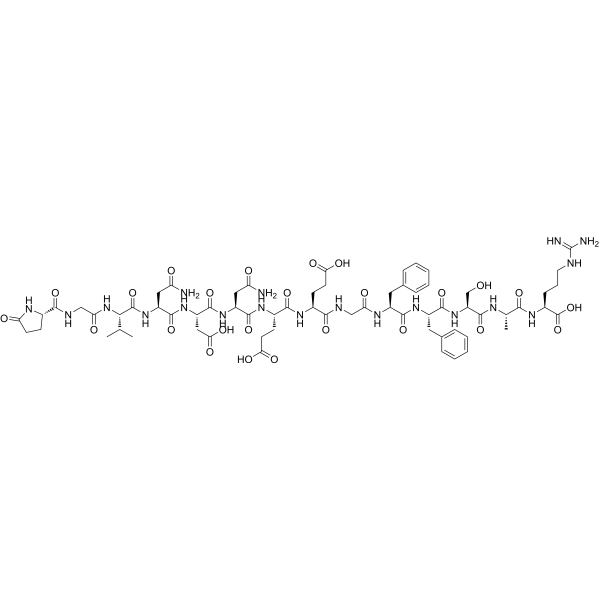
Fibrinopeptide B, human
CAS No. 36204-23-6
Fibrinopeptide B, human( FPB,human )
Catalog No. M29862 CAS No. 36204-23-6
Fibrinopeptide B (FPB) is produced during the cleavage of fibrinogen, by thrombin, to fibrin monomer.
Purity : >98% (HPLC)
 COA
COA
 Datasheet
Datasheet
 HNMR
HNMR
 HPLC
HPLC
 MSDS
MSDS
 Handing Instructions
Handing Instructions
| Size | Price / USD | Stock | Quantity |
| 5MG | 267 | Get Quote |


|
| 10MG | 462 | Get Quote |


|
| 100MG | Get Quote | Get Quote |


|
| 200MG | Get Quote | Get Quote |


|
| 500MG | Get Quote | Get Quote |


|
Biological Information
-
Product NameFibrinopeptide B, human
-
NoteResearch use only, not for human use.
-
Brief DescriptionFibrinopeptide B (FPB) is produced during the cleavage of fibrinogen, by thrombin, to fibrin monomer.
-
DescriptionFibrinopeptide B (FPB) is produced during the cleavage of fibrinogen, by thrombin, to fibrin monomer.(In Vitro):Fibrinopeptide B, human is released from the amino-terminus of the B 3-chains of fibrinogen by thrombin. Fibrinopeptide B, human (hFpB, 10 nM) causes directed cell migration of neutrophils (PMN), and fibroblasts. Fibrinopeptide B, human also possesses potent chemotactic activity relative to human complement (C5a), leukotriene B4 (LTB4), and formyl-methionylleucyl-phenylalanine (fMLP), and for fibroblasts its chemotactic activity is comparable to that of platelet-derived growth factor. However, Fibrinopeptide B, human is not chemotactic for monocytes, and shows no interaction with PMN receptor for C5a, LTB4, or fMLP.
-
In VitroFibrinopeptide B, human is released from the amino-terminus of the B 3-chains of fibrinogen by thrombin. Fibrinopeptide B, human (hFpB, 10 nM) causes directed cell migration of neutrophils (PMN), and fibroblasts. Fibrinopeptide B, human also possesses potent chemotactic activity relative to human complement (C5a), leukotriene B4 (LTB4), and formyl-methionylleucyl-phenylalanine (fMLP), and for fibroblasts its chemotactic activity is comparable to that of platelet-derived growth factor. However, Fibrinopeptide B, human is not chemotactic for monocytes, and shows no interaction with PMN receptor for C5a, LTB4, or fMLP.
-
In Vivo——
-
SynonymsFPB,human
-
PathwayOthers
-
TargetOther Targets
-
Recptor——
-
Research Area——
-
Indication——
Chemical Information
-
CAS Number36204-23-6
-
Formula Weight1552.56
-
Molecular FormulaC66H93N19O25
-
Purity>98% (HPLC)
-
Solubility——
-
SMILES——
-
Chemical NameSequence:{Glp}-Gly-Val-Asn-Asp-Asn-Glu-Glu-Gly-Phe-Phe-Ser-Ala-Arg
Shipping & Storage Information
-
Storage(-20℃)
-
ShippingWith Ice Pack
-
Stability≥ 2 years
Reference



-
6,7,4'-Trihydroxyfla...
6,7,4'-Trihydroxyflavanone possesses various pharmacological activities, including anti-rheumatic, anti-ischemic, anti-inflammatory, anti-osteoclastogenic, and protective effects against METH-induced deactivation of T cells. 6,7,4'-Trihydroxyflavanone can be used for studies about the treatment of METH-addicts suffering from neurodegenerative diseases.
-
Bak BH3
This peptide, generated from the BH3 domain of Bak (Flu-BakBH3), has been shown to have high-affinity binding to a surface pocket of the Bcl-XL protein that is required for its death antagonist function.
-
Lorundrostat
Lorundrostat (MT-4129) is an aldosterone synthase inhibitor with antihypertensive activity that lowers systolic blood pressure.



 Cart
Cart
 sales@molnova.com
sales@molnova.com


